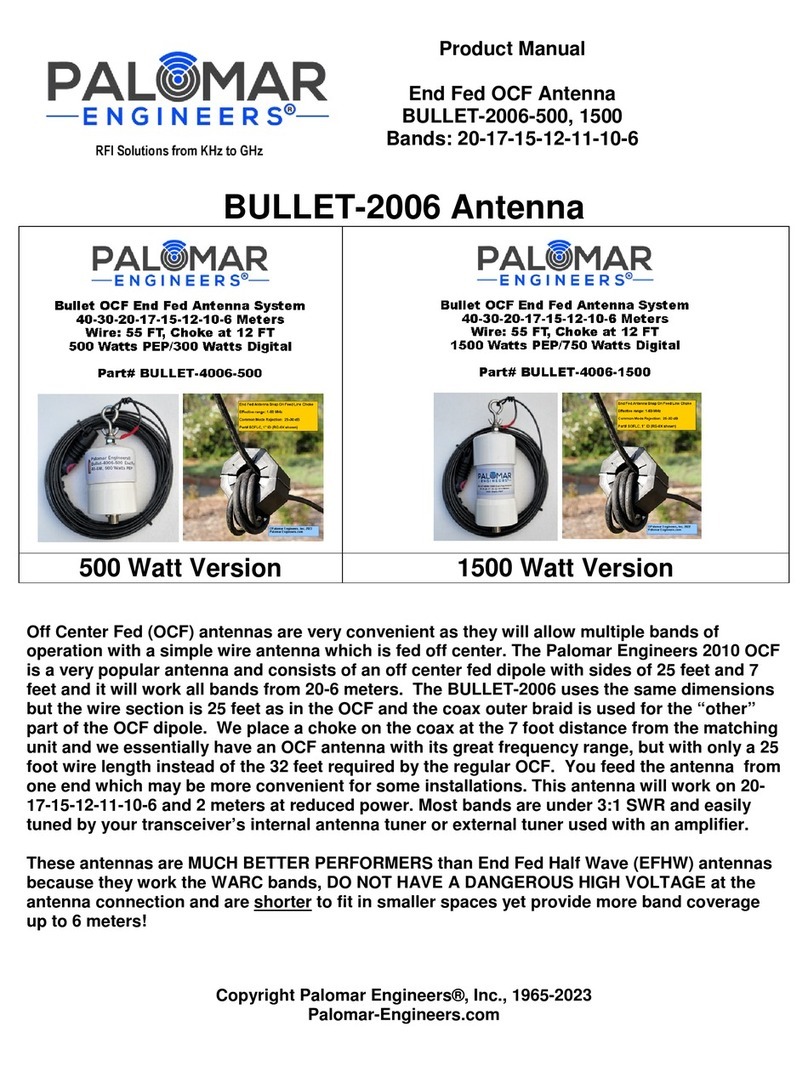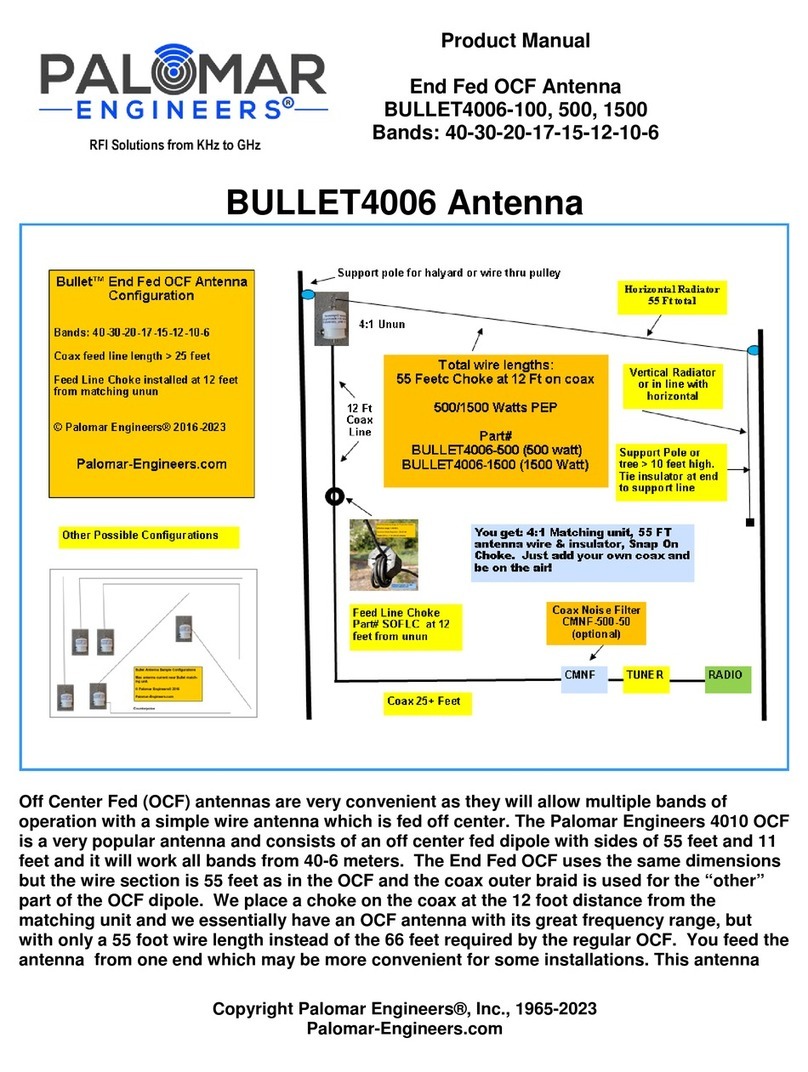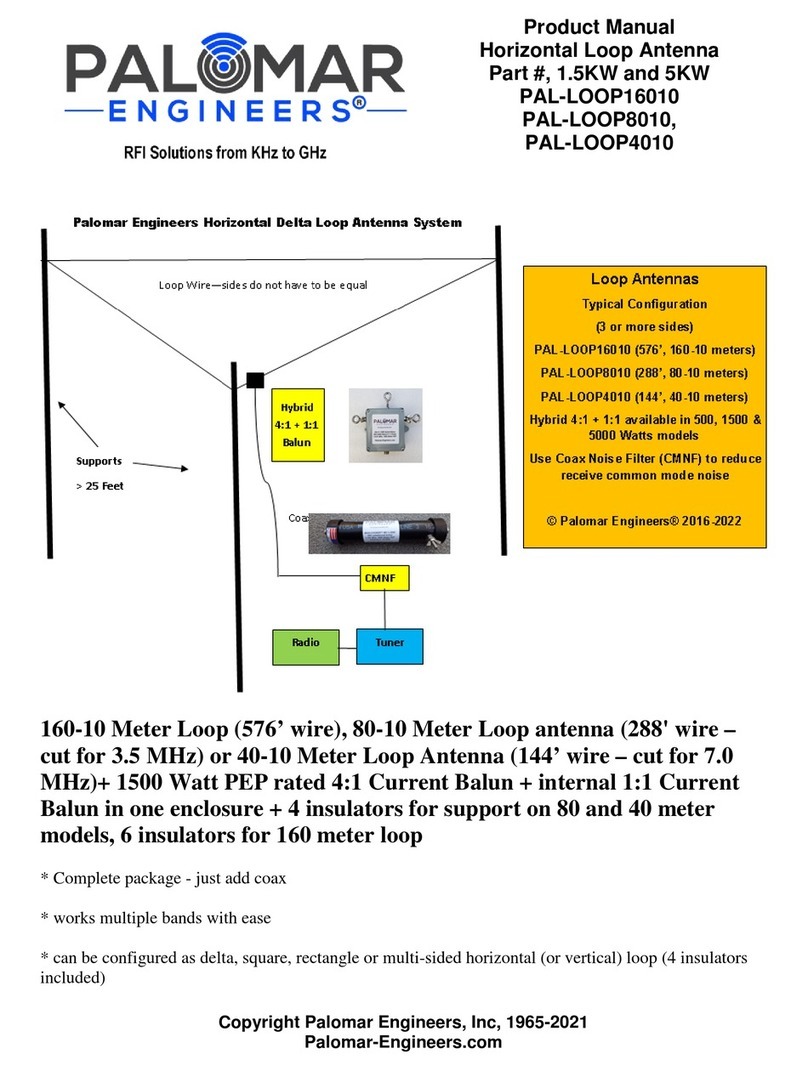
Revised 08/28/2022
side of the matching unit is in the range of 400-600 ohms and when
divided by 9 will be in the range of your transceiver antenna tuner.
Any length of 52 ohm feed line ok (50 feet minimum for 80 meter
operation) but longer feed lines over 50 feet may show reduced SWR on
some bands due to soil conductivity, nearby objects, etc. Due to local
ground conditions, antenna height and feed line length, SWR may vary
and an antenna tuner may be required or some bands to bring SWR at
end of feed line to acceptable levels.
Use a good quality 50 ohm cable adequate for the power level of your
station. The Bullet-9U-500 matching unit is conservatively rated for
500 watts PEP for SSB or 375 watts CW/digital. If the matching unit
becomes warm to the touch after transmitting at high power, reduce the
power output or the internal matching unit may be damaged.
NOTE: The matching unit output is DC grounded to bleed off static
electricity, however it is not RF grounded as the RF signal (at the coax
connector) will see approximately 1/9 of the antenna impedance on the
antenna terminal of the matching unit.
Suggested wire lengths for 1.8-61 MHz operation (measured from
Bullet wire terminal):
Bands Covered
(meters) Wire Length
(feet)
Length (FT)
80-40-30-20-17-15-
12-10-6
71
80-60-40-30-20-17-
15-12-10-6
111
160-80-60-40-30-20-
17-15-12-10-6
155
For those operators who like to experiment, the following lengths of
wire can also be used: 49, 55, 77, 92, 102, 141-148, 171, 203, 218, 268.
Changing wire length of antenna. You have two choices: extend the
current wire length with additional wire or take off the existing wire by
loosening the wire nut on the halyard hoist and slipping out the fork
spade lug from between the washers and replace with a new length of
wire as needed. Make sure you choose one of the lengths shown in the
above table so as not to have a resonant point in any of the ham bands
which will cause a mismatch for the 9:1 unun. DO NOT UNSCREW
THE HALYARD HOIST EYEBOLT FROM THE BULLET CASE
AS YOU WILL NOT BE ABLE TO SCREW IT BACK IN!!
Counterpoise Required
Ideal: In almost all cases you can use the outside braid of the coax feed
line as the single counterpoise for this antenna. See required lengths in
the above table. You will need a feedline choke at the suggested length
from the matching unit to stop the flow of RF on the braid and prevent
it from reaching your radio.
In some cases a single counterpoise may not be sufficient to tune in one
or more bands and an additional counterpoise can be added at the stud
on the matching unit. Do not ground the counterpoise stud when using
a counterpoise(s) or radial field. Counterpoise wire(s) close to or laying
on the ground will couple and become radials with reduced efficiency.
Use of one or more random length counterpoise(s) connected to the
counterpoise post of the matching unit may also improve antenna
efficiency and reduce SWR on certain bands. The counterpoise should
not be installed under the horizontal portion of the antenna for best
results. Suggested counterpoise lengths are 15, 24, 37 feet with a 50
foot coax feed and a choke installed 50 feet from the antenna feed point.
Counterpoises can be straight or zig-zagged.
Feed Line Choke Needed
Many different feed line chokes will work with the end fed antenna.
The purpose of the choke is to stop the RF current on the outside of the
coax braid from getting into the radio. In this antenna system, the outer
part of the braid acts as a counterpoise part of the antenna and you need
to suppress the current at the radio end. DO NOT FORGET THIS
REQUIREMENT!
Configurations
This antenna can be installed in a number of different configurations
including vertical, sloper, inverted L or vertical-horizontal-vertical (“n”
style). In general it is better to get the matching unit as high as possible
since the antenna current is highest near the matching unit. Horizontal
antennas and sloper antennas with the matching unit at the high end
work particularly well. Radiation will be perpendicular to the wire on
some bands and in-line with the wire on others depending upon the
frequency of operation. Have fun and experiment with different
configurations! Many different configurations and measured SWR
curves are shown on the following pages.
Coax Noise Filter
Instead of the ferrite ring feed line choke, you may use a coax noise
filter which has the dual purpose of suppressing RF from the
TRANSMITTED signal AND suppressing common mode current noise
picked up on the coax braid during RECEIVE operation.You hear this
“noise” as a higher than normal noise floor on your receiver. Vertical
antennas in general have a higher noise factor due to the vertical
polarity nature of noise sources in the neighborhood.
A simple 500 Watt PEP, high choking power Common Mode Noise
Filter (Part# CMNF-500-50) is pictured below:
To install, simply connect the coax line from the antenna to one
connector and add a small coax jumper from the other connector to your
radio. This encapsulated filter is also more durable than the ferrite ring
which can fracture if dropped on the ground. You will still need a feed
line choke at the appropriate distance from the matching unit unless the
noise filter is installed at the correct distance.






























